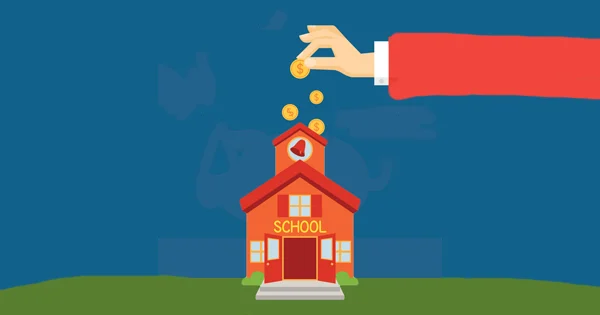School funding is one of the most critical factors influencing the quality of education. The amount of money a school receives directly impacts teacher salaries, classroom resources, technology, infrastructure, extracurricular programs, and student outcomes. However, school fund is often a topic of debate, inequality, and policy reform, as disparities in resources can lead to educational gaps between affluent and low-income communities.
Key questions arise:
- How is school fund determined?
- Why do some schools have more resources than others?
- What are the challenges and solutions for equitable school Subsidy?
In this guide, we will explore:
![]()
- The major sources of school fund
- How funding distribution works
- Challenges and disparities in school Subsidy
- The impact of funding on student outcomes
- Possible solutions for a more equitable education system
How Are Schools Funded?
school fund typically comes from three main sources:
1️⃣ Local Funding (Property Taxes & Community Contributions) 🏡
✔ Many public schools receive funding from local property taxes, meaning wealthier neighborhoods with higher property values can raise more money for their schools.
✔ This leads to funding inequalities where affluent areas have better facilities, more experienced teachers, and advanced learning programs, while lower-income areas struggle with limited resources.
📌 Example: A school in an affluent suburb might receive $20,000 per student, while a school in an economically disadvantaged urban area may receive only $8,000 per student.
2️⃣ State Funding (Sales Tax, Income Tax, Lottery Revenue) 🏛️
✔ States distribute funds based on statewide education budgets, often using formulas to ensure some level of equalization among districts.
✔ Some states use per-student funding formulas, while others consider factors like special education needs, school size, and community wealth.
📌 Example: States like California and New York use funding models that allocate more money to low-income and high-need students.
3️⃣ Federal Funding (Title I & Special Programs) 🇺🇸
✔ The federal government provides around 10% of school fund, mainly through Title I grants for low-income schools, special education (IDEA), and school meal programs.
✔ While helpful, federal funding is not enough to close the gap between underfunded and well-funded schools.
📌 Example: Title I schools receive additional funding, but it often does not fully compensate for lower local and state funding levels.
How Funding Disparities Affect Education
📉 Unequal Resources Create Learning Gaps
✔ Schools with higher funding can afford smaller class sizes, updated textbooks, technology, and well-paid teachers.
✔ Schools with lower funding struggle with outdated materials, overcrowded classrooms, and fewer extracurricular programs.
📌 Impact: Students in wealthier schools often score higher on standardized tests and have better college and career opportunities.
📊 The Teacher Pay Gap
✔ In underfunded schools, low salaries make it harder to attract and retain experienced teachers.
✔ Higher-funded schools offer competitive salaries, better training, and professional development.
📌 Example: A teacher in a well-funded district might earn $80,000 per year, while one in a lower-funded district earns only $50,000, despite similar workloads.
🏚️ School Infrastructure & Technology Gaps
✔ Wealthier schools have modern classrooms, functioning heating/cooling systems, and access to advanced technology.
✔ Underfunded schools may have leaking roofs, outdated computers, and limited Wi-Fi access.
📌 Example: During the COVID-19 pandemic, students in low-income districts struggled with remote learning due to a lack of laptops and reliable internet.
Challenges in School Funding Reform
1️⃣ Reliance on Property Taxes 🏡💰
✔ Schools in wealthier areas receive higher funding, while low-income communities struggle.
✔ Efforts to redistribute tax revenue face political resistance.
📌 Possible Solution: Implement statewide tax equalization programs that distribute property tax revenue more fairly.
2️⃣ Bureaucracy & Inefficient Spending 🏛️📉
✔ A large portion of education funding goes to administrative costs rather than directly benefiting students knowledge.
✔ Some states spend more money on school district offices than on classrooms.
📌 Possible Solution: Increase financial transparency and accountability in education budgets.
3️⃣ Political & Policy Conflicts ⚖️
✔ Funding models vary by state, leading to inconsistent resource allocation.
✔ Some policymakers push for school choice programs (charter schools, vouchers), which can divert funds from public schools.
📌 Possible Solution: Advocate for stable, long-term education funding policies rather than relying on short-term political decisions.
Potential Solutions for More Equitable school Subsidy
✅ Reforming Funding Formulas
✔ States can adjust formulas to prioritize low-income schools and provide additional resources for students with higher needs.
✔ Some states use a weighted student funding model, where funding follows students based on their specific needs.
📌 Example: California’s Local Control Funding Formula (LCFF) allocates more funding to schools with higher numbers of low-income students, English learners, and foster youth.
✅ Federal Investment in Education
✔ Increasing federal contributions to school Subsidy can help close gaps between states.
✔ Expanding Title I funding can support low-income schools more effectively.
📌 Example: Some policymakers propose doubling Title I funding to address disparities.
✅ Encouraging Public-Private Partnerships
✔ Schools can partner with businesses, nonprofits, and tech companies to provide additional resources.
✔ Companies like Google and Microsoft have donated laptops and software to underfunded schools.
📌 Example: Some school districts receive grants for STEM programs and after-school initiatives.
✅ Transparency & Accountability in School Budgets
✔ Implementing clear reporting on how funds are used can ensure money is spent on student learning rather than administrative costs.
✔ Encouraging community involvement in school board decisions can improve budget priorities.
📌 Example: Some states require schools to publish detailed financial reports showing where funding is allocated.
Conclusion: Investing in Education for a Better Future
School funding plays a crucial role in shaping student success, yet inequalities persist due to property tax reliance, bureaucratic inefficiencies, and political conflicts. By advocating for fair funding policies, increased federal support, and smarter budget allocation, we can work toward a more equitable education system that gives every child the resources they need to thrive.
💬 What do you think is the best way to improve school Subsidy? Share your thoughts below! 📚💡

